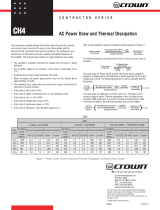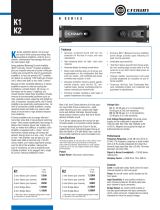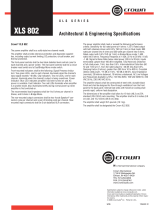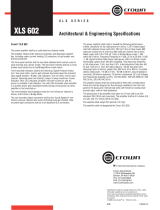
page 15
Macro-Tech MA-24X6 & 36X12 Power Amplifiers
Operation Manual
4.1.4 Transformer Thermal
Protection
All Macro-Tech amplifiers have transformer
thermal protection. It protects the power sup-
plies from damage under the rare conditions of
transformer temperatures rising too high. A
thermal switch embedded in each transformer
removes power to the channel if there is exces-
sive heat. The switch automatically resets when
the transformer cools to a safe temperature.
It is very unlikely that you will ever see a
Macro-Tech amplifier activate transformer ther-
mal protection as long as it is operated within
rated conditions (see Section 7, Specifica-
tions). One reason is that ODEP keeps the
amplifier working under very severe conditions.
Even so, higher than rated output levels, exces-
sively low impedance loads and unreasonably
high input signals can generate more heat in
the transformer than in the output devices.
These conditions can overheat the transformer
and activate its protection system.
Macro-Tech amplifiers are designed to keep
working under conditions where other amplifi-
ers would fail. But even when its limits are
exceeded, it will still protect itself—and your
investment—from damage.
4.1.5 Circuit Breakers
The power supplies are protected by circuit
breakers. With rated loads and output levels,
the circuit breakers should only shut down the
amplifier in the rare instance of a catastrophic
failure. Other protection systems like ODEP
keep the amplifier operational under most other
severe conditions. The circuit breakers can also
shut down the amplifier in cases where
extremely low-impedance loads and high out-
put levels result in current draw that exceeds
their rating. Again, this should only be possible
when operating outside rated conditions, like
when the amplifier is used to drive a 1-ohm
load in Stereo mode, or when a signal over-
loads the input and is clipped severely.
Macro-Tech amplifiers do not trip their break-
ers unless something is wrong. If a breaker
trips, try to identify and correct the problem
before resetting the breakers with the back
panel Reset switches. If the problem persists,
refer the unit to a qualified technician.
4.2 Circuit Designs
4.2.1 Grounded Bridge
Grounded Bridge is the name of Crown's
unique four-quadrant amplifier topology. The
Grounded Bridge topology takes full advantage
of the power supplies delivering peak-to-peak
voltages to the load that are twice the voltage
seen by the output devices and twice the volt-
age generated by the power supplies.
The power supply bridge rectifier is not ground
referenced, and the transformer secondary is
not center-tapped. This allows the power sup-
ply to deliver +VCC and -VCC from the same
bridge rectifier and filter as a total difference in
potential regardless of their voltages with
respect to ground.
Composite output devices are arranged to func-
tion as gigantic NPN and PNP devices. Each
output stage has two composite NPN and two
composite PNP devices. The devices con-
nected to the load are referred to as “high-side
NPN and PNP” and the devices connected to
ground are referred to as “low-side NPN and
PNP.” Positive current is delivered to the load
by increasing conductance simultaneously in
the high-side NPN and low-side PNP stage,
while decreasing conductance of the high-side
PNP and low-side NPN in synchrony.
Crown's Grounded Bridge design delivers large
voltage swings without stressing output tran-
sistors. The results are higher efficiency, lower
distortion and superior reliablility.
4.2.2 Variable Impedance (VZ)
(Macro-Tech 36X12 only)
VZ is the name of Crown's patented articulated
power supply technology. This innovative tech-
nology permits us to pack large amounts of
power into a compact package while achieving
ultra-low distortion and without generating
excessive heat.
An amplifier power supply must be large
enough to handle both the maximum voltage
and maximum current necesary for the ampli-
fier to drive its rated power into a specified
load. In order to meet this requirement, most
conventional supplies are heavy, large, and
produce lots of heat. In contrast, the VZ supply
gets more current AND voltage out of a smaller,
lighter, and more efficient package by dynami-
cally adapting to both signal and load require-
ments in real-time. This provides the best
power match to the widest range of loads.
The VZ supply is divided into two segments.
When the output stage requires high-voltage,
the segments are arranged in series to deliver
twice the voltage of a single segment. When the
output stage requires high-current, the seg-
ments are arranged in parallel to deliver twice
the current of a single segment. Sensing cir-
cuitry "watches" the voltage of the signal to
determine when to switch VZ modes. The
switching circuitry is designed to prevent audi-
ble switching distortion to yield the highest
possible dynamic transfer function—you hear
only the music and not the amplifier.
With VZ, you get not only maximum power and
safety, but you also get the best power match-
ing to your load.
4 Advanced Features
and Options































